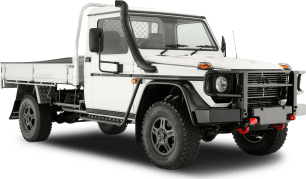Let's cut to the chase. The G 63's pure grunt overpowers its challenging aero profile to thrust this boom box on wheels from 0-100km/h in a claimed 4.5 seconds. And believe it or not, despite its greater length and width, it has enough power to punch a 240km/h hole in the air (maximum velocity is limited to 220km/h if you choose not to opt for the 'AMG Driver's Package').
The new electronic architecture brings with it the latest version of Merc's 'Dynamic Select' system with five driving modes adjusting the engine, transmission, suspension, steering and assistance systems right up to maximum attack Sport+ mode.
All 850Nm of peak torque is available between 2500-3500rpm and pinning the throttle anywhere in that band feels like lining up a runway and preparing to rotate for take-off.
The two-stage exhaust flap arrangement allows you to turn the noise up from growl to roar even at modest around town speeds, and the nine-speed transmission is sharp and positive, with the multiple downshift function (in manual mode) hilariously good fun.
The racy AMG sports seats are as grippy as they are comfortable, and the fat 295/40 Goodyear Eagle F1 rubber, wrapped around the optional 22-inch forged alloys, does a good job of keeping all that mass and momentum in control as the high riding G 63 careens around corners.
And speaking of mass, the job of hauling it from warp speed to rest sits with big ventilated discs all around (cross-drilled 400mm front/370mm rear), clamped by monster six piston calipers at the front and single piston at the back. They're progressive and reassuringly powerful.
So, the performance is as dramatic as ever, but when I think of previous Merc-AMG G-Class offerings, two main shortcomings come to mind... steering and ride.
The steering was like a laggy mouse, with a few beats separating input at the wheel from response at the front treads. And the damping came up short, with a bouncy ride par for the course.
Still sitting on a ladder-type frame, the new G's suspension was developed by Mercedes-Benz and Mercedes-AMG. And finally, it has a decent double-wishbone independent front-end, with a rigid axle at the rear and coil springs all around. Plus, a strut tower brace, Merc-AMG calls it a 'suspension bridge', now connects the front strut towers, increasing torsional rigidity.
Ride comfort, especially in the most compliant 'Ride Control' suspension setting and riding on the big 22s, is massively better. It's no limo. You'll still feel jittering over higher frequency imperfections. But it's way, way ahead of the first-gen version.
The steering system changes from a recirculating ball to rack and pinion, and is now variable ratio with electro-mechanical rather than purely hydraulic assistance. And it's also much improved. We're not talking about a Lotus Elise-style connection with the road, but the steering is clearly more predictable and responsive.
One thing that hasn't changed is an ocean liner-worthy, 13.6m turning circle. You'll need to plan ahead for U-turns and reverse parks, but enough parking cameras (including surround view) to please Cecil B DeMille are on hand to help.
It's like a whole new world with a familiar cover wrapped around a markedly improved package. But (there must be a but) visibility is still compromised by thick window and door pillars, and despite the new dash layout ergonomic efficiency is patchy, with some switches and knobs located in relatively awkward positions.
As mentioned earlier the G 63 features three 100 per cent diff locks and low-range off-road gear reduction. But forget breakover angles and wading depths. This 4x4 seeing off-road action is as likely as an Abbott 2.0 prime ministership.
Suffice it to say, this car wears the 'Schöckl' badge at the base of its B-pillar. And in case you were wondering, Schöckl is a 1445m mountain in Graz, the Austrian city where the G-Class is built (and big Arnie Schwarzenegger was born!).
In the second-gen G-Class's development, prototypes covered roughly 2000km over a five kay trail including gradients of up to 60 per cent and lateral inclines up to 40 per cent. So, despite its irrelevance, the off-highway box is ticked.

